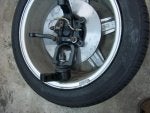I’m happy for any idea that can solve my problem(s).
Valve lash was 0.2-0.25mm all around and two valves where 0.25-0.30mm.
I thought if I throw a big(!!) pile of money at this engine I don’t have to worry about a thing.
But now look where I am, discussing tiny little details on the internet, sending pictures, making calls, driving to places, and right now it looks like a several years long court case to me.
I’m a mechanical engineer by trade, I build several engines, mostly 600cc and 2stroke but this time I just hadn’t any motivation to do it myself but that didn’t turn out too well.
Kind regards
Chris
-----------------------------------------------------------------------------------------------------------------------------------
Although you said this "mechanic" has "said" he has worked on 100 Alfa engines" no Alfa mechanic that has been inside an alfa head would have finished this head with the cutting and use of incorrect parts. Those being the long guides inserted where the Cam Lift of the good CatCams require short guides for adequate spring height for the guides and seal height to have adequate clearances.
The guides I use in every Alfa head I build are the short bronze guides designed for use in the 3.0 liter
V6 on the EXHAUST side. (Centerlinealfa part #VG245) using the Reintz green (short seal) CLs part # is
VG191. These short guides are set in the head leaving NO MORE than 10mm -12mm above the floor, including the reduced diameter area for the Green seals to be fitted. In valve lifts less than 12mm total height above the floor is safe at 12mm. These still leave a reduced exposure in the ports for less disruption of the Fuel/air mix flow. These guides have a groove around the bottom area, and should be right below the aluminum floor of the spring pocket. Then the aluminum can be compressed to provide an additional restriction to prevent guide movement.
I suspect as I have expressed that the lash is improper depending on CatCam`s lobe profile either having no raised bump to soften seat pressures or using to much lash (over the Manufacturer`s specification. Which I have not seen)
Do you have the factory lash setting for these 2 CatCams and the "lobe lift" (not valve lift which is less the
lash settings)
I`ll see if i can find the specs of your cams on CatCam`s website.
Good luck with this.
Rj






